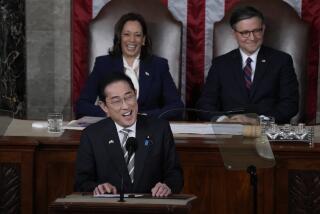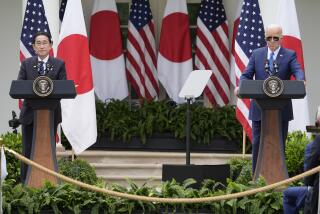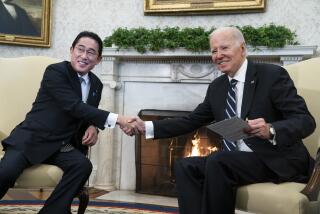Getting Japan on the U.S. Bandwagon
During the next few days, President Bush, accompanied by some U.S. business leaders, will visit Japan. The President’s trip was initially billed as an occasion to strengthen cooperation between the United States and Japan.
Now, laboring under the burden of a stagnant U.S. economy at the dawning of an election year, the President has taken to billing it as an opportunity to pry open Japanese markets. To make the most of this opportunity, however, Bush and his business delegation must distinguish between politically expedient myths and economically persuasive realities. Otherwise, they run the risk of antagonizing their Japanese hosts without achieving any gains for the U.S. economy.
Since bashing rather than negotiating seems to be the order of the day, at least it should be informed bashing. This requires that Bush take heed of the following two points.
First, contrary to the self-serving claims of some U.S. politicians and business leaders, Japan’s trading practices did not cause our recession. We managed that on our own. Our financial house of cards has come tumbling down under the weight of excessive debt and bad loans. The Federal Reserve, still fighting the last war against inflation, has waited too long to ease the credit-crunch strangling domestic spending. Meanwhile, fiscal policy has been paralyzed by a decade of tax-and-spend deficits created by the irresponsible supply-side economics of two successive Republican administrations.
Ironically, exports to Japan and the rest of the world have been the major source of growth since Bush became president. Between 1987 and 1990, exports to Japan, the United State’s second-largest foreign market, increased by 72%. Unfortunately, U.S. exports have faltered this year in response to slower growth in both Japan and Europe. But abroad, as at home, tight credit, not trade barriers, triggered the slowdown. From this perspective, the decision by the Bank of Japan to lower its discount rate in anticipation of Bush’s visit may prove to be its most significant accomplishment.
Second, Japan’s trading practices are not the primary, let alone the sole cause of the difficulties of the U.S. automobile industry. Again, most of the responsibility lies at home. Aided by sharply higher oil prices and a nonexistent U.S. energy policy, the Japanese automobile producers made huge inroads into the U.S. market in the late 1970s with smaller, more fuel-efficient models not available from their U.S. competitors. Thereafter, the Japanese companies increased their share of the U.S. market through superior productivity, quality and style. Today, even the staunchest advocates of the U.S. industry are hard pressed to deny that Japanese auto companies are the world’s most efficient. And this despite the fact that U.S. producers benefited from protectionist quotas on Japanese imports during the first half of the 1980s.
Why have U.S. auto producers been overtaken by the Japanese? In the anti-union atmosphere of the 1980s, the popular scapegoat was the U.S. work force, but every reputable study concludes that management has been the primary culprit. Certainly, it begs credulity to suggest that General Motors’ current woes were caused by its workers. One need only look at the GM-Toyota joint venture in Northern California to see how Japanese management principles can significantly increase the productivity, quality and morale of U.S. auto workers. Nor can the greed of GM’s workers be blamed for the company’s red ink. The real wages of GM workers stagnated during most of the 1980s, while GM’s CEO earned more than four times what the heads of Nissan and Toyota earned. During this period, GM lost market share not just to the Japanese but to Ford and Chrysler as well.
Although the Japanese are not responsible for the United State’s recessionary woes or the shortcomings of its automobile companies, Bush is on firm ground when he argues that the Japanese market is significantly more closed than the markets of the other advanced industrial nations. This is true in automobiles and auto parts, just as it is true in such diverse products as rice, wood products and semiconductors. In the auto sector, for example, the Japanese have won almost 30% of the U.S. market while American producers have gained less than 3% of the Japanese market. Japan’s controlled distribution system and the exclusive keiretsu relationships linking Japanese customers and suppliers are the major obstacles blocking access to Japan’s auto market.
During the 1980s, the United States and Japan successfully negotiated several bilateral agreements that reduced structural impediments to the Japanese market and increased competitive opportunities for American producers of cellular telephones, supercomputers, financial services and semiconductors. If Bush wishes to bash appropriately and with all due politesse, he should praise the Japanese for their cooperation in making these deals and request a similar approach to automobiles and auto parts, which together account for more than 75% of the total U.S.-Japan trade imbalance.
But enhanced competitive opportunities are not the same as balanced trade. If we demand balanced trade with Japan, as some suggest, the Europeans have every right to demand balanced trade with us, thereby eliminating a $20-billion trade surplus and the jobs, sales and profits it generates. If every nation insists on balanced trade with every one of its trading partners, then barter, autarky and global stagnation are not far behind.
While Bush lobbies the Japanese for more open markets, he should actively disavow proposals by some U.S. and Japanese officials to reinstate a formal quota on Japanese exports of autos and auto parts to the United States. Such proposals make a mockery of bona fide U.S. efforts to open foreign markets and strengthen the General Agreement on Tariffs and Trade. In addition, unconditional protection in the auto industry will do nothing to solve the long-run competitive difficulties of domestic producers. The only certain outcome is that American consumers will pay higher prices for their automobiles, regardless of where they are produced or by whom.
Finally, Bush should commend the Japanese auto companies for their substantial investment in the United States and urge them to do more. The available evidence indicates that their U.S. operations are at least as good as those of American companies in terms of output per worker, compensation per worker and research and development spending per worker. However, Bush should highlight one glaring difference between Japanese transplants and U.S. companies. The former are far more dependent on parts manufactured abroad, specifically in Japan.
The Japanese auto makers, eager to secure their access to the United States, have announced voluntary plans to buy significantly more American-made parts, primarily for their U.S. operations, by 1994. Bush should endorse these plans and stress that greater local content and equal competitive opportunities for U.S. parts suppliers are defining conditions of good corporate citizenship for Japanese automobile transplants. The basic message the President should leave with the Japanese auto firms is: If you want to sell more cars in the United States, produce more cars here using more U.S.-made parts.
Even as Bush chides the Japanese for the obstacle course their markets have become, he should express proper awe at their economic accomplishments. For while Japan is emphatically not the cause of our long-run economic malaise, its example may well provide the prescription for its cure. Perhaps we should bash the Japanese into developing a strategy for our own economic revival. Based on recent history, it figures to be far more efficacious than any that the Bush Administration and Congress are likely to devise.
More to Read
Inside the business of entertainment
The Wide Shot brings you news, analysis and insights on everything from streaming wars to production — and what it all means for the future.
You may occasionally receive promotional content from the Los Angeles Times.










